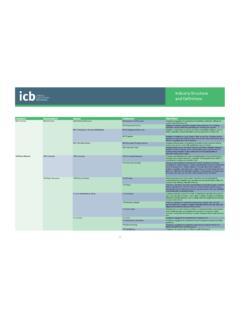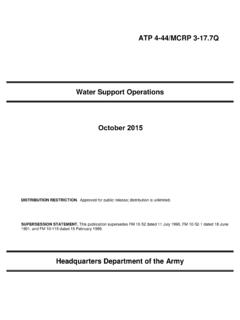Transcription of Glossary of Investment Terminology
1 Prepared for the Community First FoundationGlossary of Investment Terminology2 Basic TermsStock:A type of security that indicates ownershipin a company and represents a claim on that company s earnings and assets. Bond:A debt instrumentin which aninvestor loansmoney to an entity ( Governments or Corporations) that borrows the funds for a specific period of time at a specified interest rate. Fixed Income:A type of investing for which realreturn ratesor periodicincome is received in regular intervals at a reasonably predictable level. The most typical fixed income security is the :A collection of stocks and/or bonds. Portfolios are helddirectly by investors and/ormanaged by financial Manager: A financial professional or team of professionals hired to oversee the selection of investments within a portfolio.
2 The terms Fund Manager or simply Manager will also be used. Futures:An exchange-traded transaction that provides for the sale or purchase of a specific amount of a financial instrument, currency or commodity at a given price, at a designated time in the : Refers to the distribution of assets among a variety of asset classes / investments, for example, geographic regions, instruments, Investment styles and strategies, and sectors to reduce the risk characteristics of a Benchmark: A standard by which the performance of a security, fund, or other asset can be measured against. Typically an unmanaged basket of stocks or bonds, an index portfolio, is used for Ratio:A measure used to compare a stock s market value to its net asset value, or book value.
3 It can be calculated by dividing the current market price of a stock by the current book value per share. This ratio gives an investor an idea of how much they are paying for the stock relative to the company s underlying Ratio:A measure of a company s price per share as compared to its earnings per share. The P/E ratio shows how much an investor would be paying for every $1 of earnings. For example, a company with a P/E of 20 would be paying $20 for every $1 of Terms of Return: Measure indicating Investment performance, including appreciation (or depreciation), realized gains (or losses), and income. Gross Rates of Return: The rate of return beforethe deduction of Investment management Rates of Return: The rate of return afterthe deduction of Investment management Return:The constant rate of return that, compounded annually, would yield the same overall return for a multi-year period as the actual return observed.
4 Annualized return is the preferred quoted return rate for multi-year b ilitie - Assets Intangible -Asset TotalP ric eStock /=BPshareper EarningsP ric eStock /= Terms : In the Investment world risk is broadly defined as not meeting a stated overall investing objective. More narrowly defined risk can be though of as the chance that an investments actual returnwill bedifferentthan expected. This naturally includes the possibility of losing some or all of the original Investment . A fundamental idea in finance is the relationship between risk and return. The greater the amount of risk thatan investoris willing to take on,the greater the reason for this is that investors needto be compensated fortaking onadditionalrisk.
5 Investment Risk is typically measured with the statistical concept of standard deviation . This concept is further explained later in the :The concept of liquidity refers to how quickly an Investment can be converted back into spending cash without affecting the investments price. Most stocks and bonds can be sold for cash settlement in 3 business days. Hedge Fund: Pools of capital that can invest with few restrictions as to asset classes, Investment strategies and leverage. Hedge funds are typically not registered with the SEC, and are primarily sold to institutional and qualified investors. Risk, strategies, and styles can vary widely. The technique of hedging means to reduce risk.
6 Hedge funds can be in the form of a single-manager fund or multi-manager fund of hedge funds (FOHF).5 Style-Based InvestingStyle: The Investment approach an investor, fund manager, or other party utilizes to make Investment selections for a portfolio. Style can be a useful tool for classifying portfolios (or baskets) of stocks and bonds. For Equities, a company s size (market capitalization) and whether the company is considered Growth or Value determine a stock s style. International stocks are typically broken down into Developed and Emerging Markets. Samples can be seen below and will be further defined later in the and Quality are factors most commonly used when determining the Style of a CapRussell 1000 ValueRussell 1000 russell 1000 GrowthMid CapRussell Mid Cap ValueRussell Mid CapRussell Mid Cap GrowthSmall CapRussell 2000 ValueRussell 2000 russell 2000 GrowthDomesticFixed IncomeInternational StocksQuality Maturity Developed EmergingMarkets 6 Style-Based Investing Capitalization and Value versus GrowthInvesting by CapitalizationMarket Capitalization ( or Market Cap):The total dollar market value of all of a company s outstanding shares.
7 Market capitalization is calculated by multiplying the number of a company s outstanding shares by the current market price per share. Market Capitalization s can be classified as either Large, Mid, or Cap:Companies classified as Large Cap have market capitalization's in excess of $10 billion. Companies such as Wal-Mart, Coca-Cola, and IBM currently fall within this category. Large Cap stocks are considered to be relatively stable and Cap: Mid Cap companies have market capitalization's between the $2 - $10 billion range. Companies classified as Mid Cap include Amazon, Bed Bath & Beyond, and Express Cap stocks are generally considered to be more volatile than larger capitalization Cap: Companies with total market capitalization s below $2 billion are considered Small Cap.
8 Examples include Pediatrix, Oceaneering, and , these are companies early in their lifecycles and have significantly shorter track records. Investing by Value or GrowthValue Investing:An investmentstrategy for picking stocks that trade for less than their intrinsic value, with intrinsic value being defined as the perceived value of the company. The value investor considers fundamentals more important than market factors for determining a stock s price. Typically, value investors select stocks with lower-than-average price-to -book and price-to -earnings ratios as well as high dividend yields. The value investor is conscious not to pay too much for a Investing: An Investment strategy that selects stocks which are expected to grow earnings at a higher rate than the overall market.
9 A growth investor may look to find stocks within growth industries (for example Information Technology or Biotech ). The investor in a growth strategy is not usually concerned with the price paid for an Investment . 7 Benchmarks russell Equity Indices russell Indices: The russell Equity indices are built from a universe of 3,000 stocks and divided between value and growth. Some individual stocks may be split between the growth and value indices where appropriate, but their total representation will always equal 100% of their total market capitalization. All russell indices are capitalization weighted unless otherwise noted and are rebalanced each year on June 30th.
10 Please Note: Fees and expenses involved in trading stock are not taken into account when determining index IndicesRussell 3000 :The russell 3000 index measures the performance of the 3,000 largest companies based upon total market capitalization, which also represents 98% of the investable Equity market. The composition of all other russell indices can be related to the russell 1000:The russell 1000 Index is a large cap equity index consisting of the largest 1,000 stocks in the russell 3000 Index. russell Midcap:The russell Midcap includes the smallest 800 stocks in the russell 1000 Index. russell 2500:The russell 2500 Index is a small to mid cap equity index consisting of the smallest 2,500 stocks in the russell 3000 Index.



